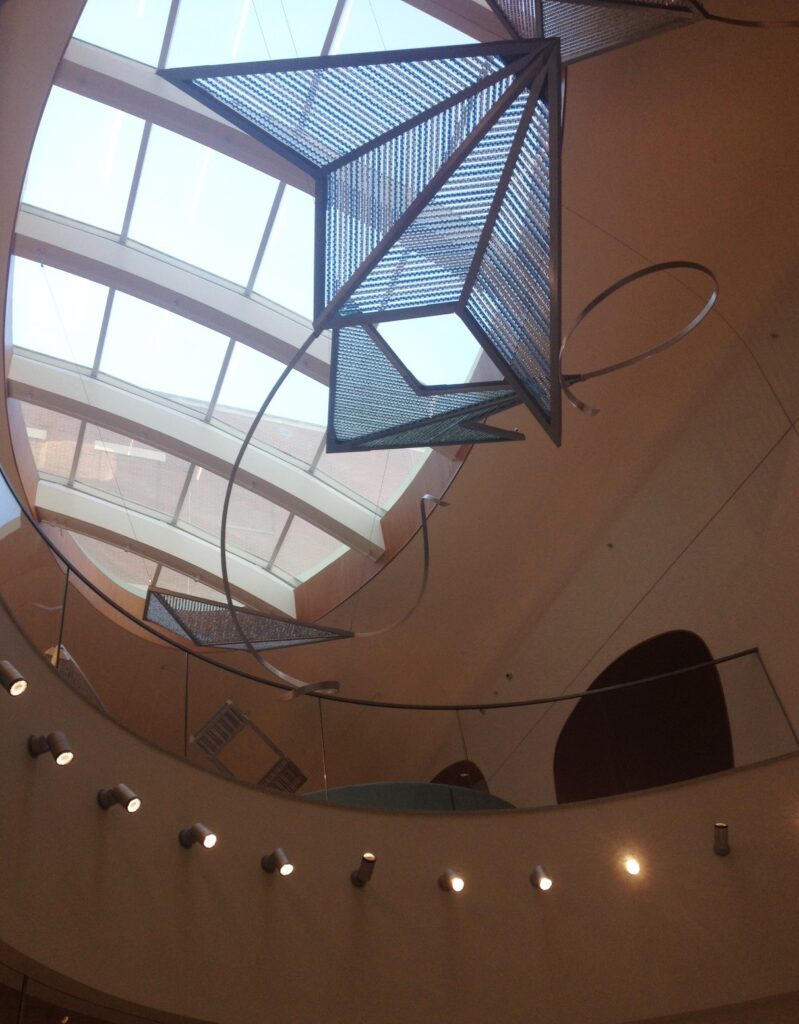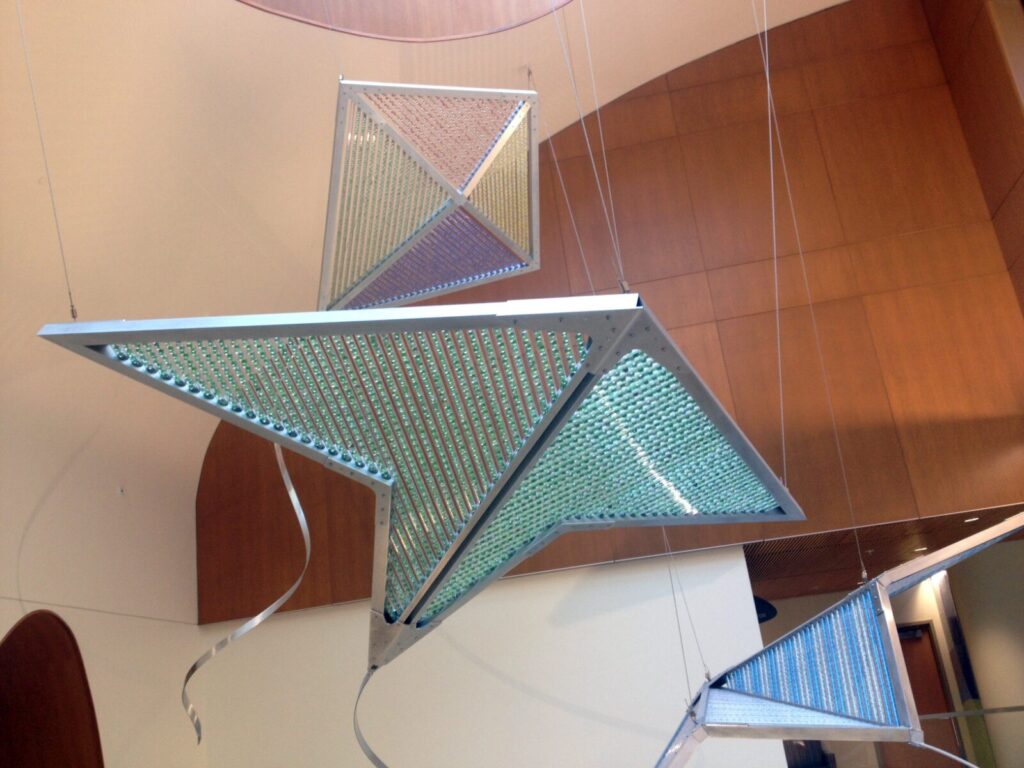In the first chapter of philosopher Gaston Bachelard’s 1964 treatise on the intimacy of personal spaces, The Poetics of Space, he notes that the houses of childhood daydreams are often vertically oriented. These dream spaces move from the fear and anxiety of dark basements and cellars to the bright fresh air of warm and sunny attics.
Such an orientation is not lost on Erika Strecker’s and John Medwedeff’s Exuberance! at the Kentucky Children’s Hospital. The installation consists of seven aluminum kites that snake up two floors to finally hang motionless but graceful just below the expansive skylight that looms over the hospital’s lobby. Though the artists’ aim was at first something “happy and uplifting,†the installation adds more to its space than a pleasing and whimsical backdrop. Its effect is much more nuanced and presents an opportunity for prolonged and poignant contemplation that burrows much deeper than the brief time I was able to spend with it. The diversity of the space and those that use it is integral to what this installation is ultimately able to do.
In regards to materials, the artists combine a kind of industrial aesthetic that borrows from the space’s architecture and a softer, nostalgic core buoyed by shapes and objects of childhood play. The dull metal of the kites’ aluminum chassis, bracketed and bolted together in echo of the metal frames of the windows above, is balanced against thousands of glinting marbles in transparent tubes. Marbles, like the kites these objects take after, are the realm of a child’s interests and preoccupations. Positioned as the material heart of each kite shape, the marbles sustain the overall objects and further integrate them into the space through the subtle catch and recolor of light that filters down. The thousands of marbles, end to end in their tubes, add a subtle complexity that begins to move them beyond the logic of appearances to other spaces.
Like in a daydream, these kites emerge from a logical place outside of the reality of their installation. In their strangeness and even the unfeasibility of their material, as objects they allow the viewer to enter someplace else, a place where reality and all its traumas is potentially assuaged by childhood’s simpler concerns.

As an installation the work exists in more than one kind of space. Space plays a heightened role here, not just because that is the nature of installations, but the broader implications of the complex hybridization of the particulars of the building in relation to its uses. The work exists on a threshold, a literal and figurative lobby between the outside world and the building’s decidedly non-art interior. The larger lobby area of the hospital complex is open and breezy. Light pours in across the gently slopping walls from a plethora of windows and glass ceilings.
The ground and first floors are essentially contiguous, broken only by a mezzanine that meanders though the building’s several pavilions. Vitrines that contain an array of sculptural objects, from industrial assemblages to brightly painted folksy woodcarvings, are interspersed along walls also hung with prints and paintings. It might be easy to forget that just beyond these calm and quiet places, separated by only a few walls, are the linoleum-tiled floors of narrow hallways that branch off to patients’ rooms and surgical suites. Yet even in the midst of the hospital’s less publicly accessible interior, artwork is likewise displayed for the same purpose as in its lobbies and pavilions. Not cold and clinical, this is ultimately a place for health and healing aided by the collaborative effort of many artists and their work.
Such thoughts are not lost on the staff, children, or families who sit in these art-filled lobbies as a respite, if only temporarily, from the anxieties and realities of sickness so close at hand. It is in this way that the effect of Strecker’s and Medwedeff’s installation is most acute. This isn’t traditional art space, though there is still art here. Instead, art and people share the space in a more symbiotic way. While I was in the first floor lobby gazing up at the metal-framed kites and seeing how the light diffused through their hundreds of marbles, two women in scrubs sat at a low table in the corner and played a card game.
In many ways, my visit was uncommon. This installation is more an element of the ebbs and flows of the hospital’s daily life than something to be specially singled out and visited on its own. Yet even for someone who might only spend a few minutes gazing up at the work, it offers an opportunity for wonder and contemplation. There is still the potential for meditation in its presence even for such a short encounter, a fact that the artists seem to have consciously allowed to guide the design and implementation of the installation. In this space, the short-term and long-term are both offered as opportunities for healing.
Downstairs, the small circular sitting room where the first kite begins its journey was empty as well. From here, the kites seem to rise up into the brightly lit atmosphere above. Far away I heard the murmurs and footsteps of people coming and going. This mixed with the gentle humming of a TV that displayed a video game’s idle menu screen, another kind of lobby open to be taken up and used by someone in need of a distraction. It strikes me that this is the reality of Exuberance! and its presence here. In a place that needs to be something beyond the harsh realities of life and death, a meditation on childhood’s easy slip into wonder is a welcome offering.





